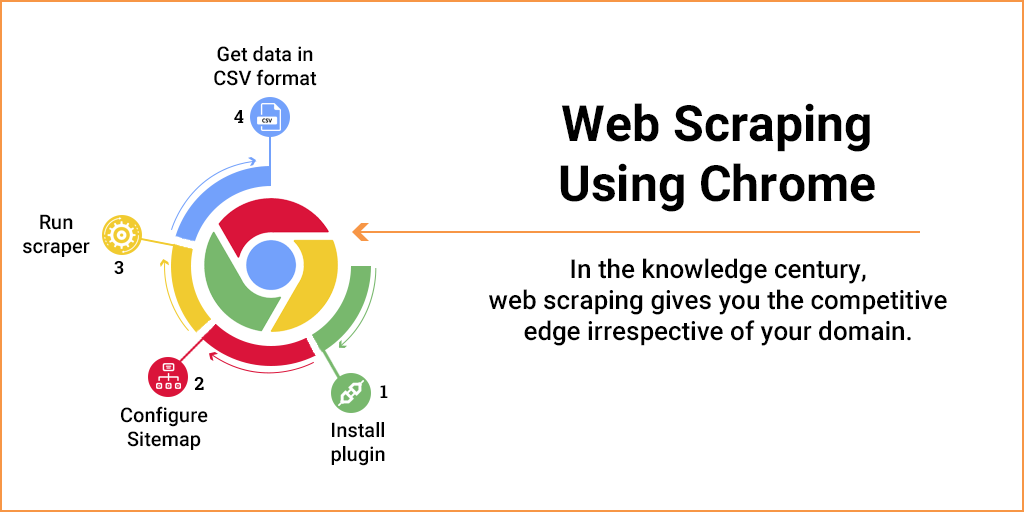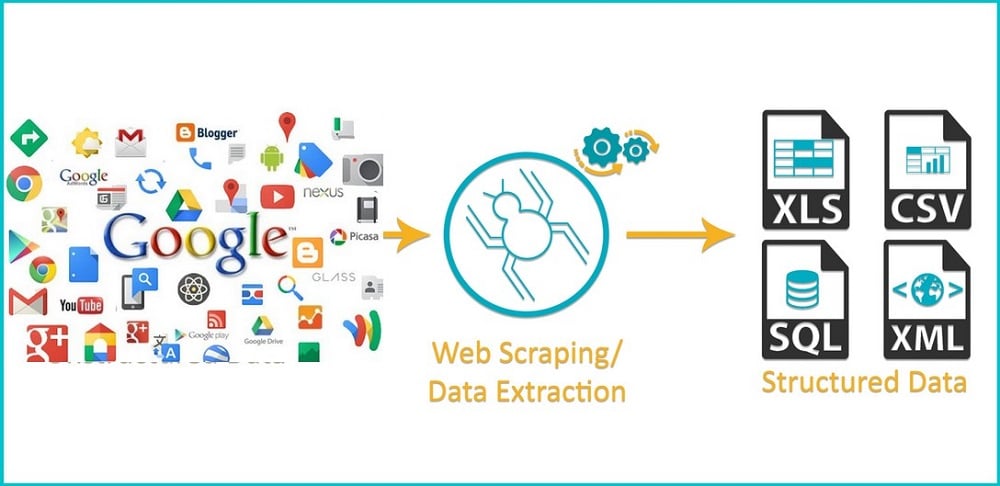Scraperis aGoogle Chrome extension. Scraper is a handy scraping tool, perfect for capturing data from web pages and putting it into Google spreadsheets. This tool stands in line with the otherscraping software, services and plugins.



What is web scraper chrome extension? Web scraper chrome extension is one of the most powerful tools for extracting web data. Using the extension, you can devise a plan or sitemap regarding how a particular web site of your choice should be navigated. Web scraper - Chrome extension. Skills: Web Scraping, JavaScript, Google Chrome, Python, PHP. See more: hello i need a logo for my site details in private, hello i need a. Web Scraper Web Scraping Web Scraping using web scraper chrome extension Web Scraper Tutorial. Web Scraping Service Web Scraping Using Google Chrome. A Google Chrome extension for getting data out of web pages and into spreadsheets. Highlight a part of the page that is similar to what you want to scrape. Right-click and select the 'Scrape selected.' The scraper window will appear, showing you the initial results.
Proxycrawl Google Scraper was not originally made as a regular web scraper, but as a scraping API, you can use it to extract structured data from Google search engine result pages. Some of the information you can scrape includes keyword related information such as.
Get Started
Let’s start with installation of this Chrome extension. You may get it here. After installation and activation, go to Londonstockexchange indexes and right-click on any link in the left index list and select ‘Scrape similar’:
Scraper Dashboard
A new window will open and you should see something similar to the one below. Scraper has two options for identifying the parts of the page you want to extract, XPath selector or JQuery selector. Those identify multiple elements (e.g., a table or a list), rather than a single HTML element. XPath provides a way to identify parts of the XML/HTML structure to extract content. To become more familiar with XPath, just visit “About XPath” or take a look atw3schools.In this example, Scraper should default to //td/a/@href. Here’s a quick explanation of how to read this query:
- Since it starts with // it will select “nodes in the document from the current node that match the selection no matter where they are”.For me, this is a trigger to read the query from right to left as we are matching an endpoint pattern.
- “@href”refers to the attribute whose name ishref; that is the URL we need.
- “a”refers to the<a>node.
- “td”refers to<td> within the structure.
You may edit the XPath expression, whether atSelectoror atColumnsarea, as well as change the column names. Click “Scrape” and the Scraper will reload with improved results. In the picture above, I added/@hrefto get only URLs rather thanLinknames too.
Refining & Editing Results
As you notice, the URLs we got from the web are just suffixes with a base URL missing. So now, I’ll concatenate using the in-built Google Docs function:CONCATE(string1, string2). Get the base manually online athttp://www.londonstockexchange.com. Type in the adjacent cell=CONCAT(“base url”, A2)and press enter. Don’t forget: the strings are to be always quoted when in functions, indexes not:
Now, select cell B2 and fill the column down to get full URLs for all the links. That’s it.
How to select and auto-fill: put the cursor into the bottom-right corner of a cell, turning its image into a thin cross, press it and pull it down to auto-fill.
Other Points to Mention
When you want to scrape tabled structures, select an area and again right-click “Scrape similar”:
This Scraper doesn’t identify images, unless you specify a link to image inside the HTML element using an additional Xpath selector, as in the picture below:
How to Get an Additional XPath Selector to Image Link
- Enable Google Chrome developers tool by F12 or Ctrl+Shift+I.
- In the tab that appears, pick the loupeto point (& click) at the element, and then right-click at the highlighted element in the tab and selectCopy XPath!
- I cut the last part of XPath expression to be an additional selector, the last part being‘/img’ and I added‘@scr’ to select the very ‘scr’ attribute value.
No sorcery, just try it!
Web scraping is the best method to gather data from websites. Scraping tools such as Web Scraper help users to scrape websites easily. In this post we will show you how to scrape data using the Web Scraper Chrome Extension.
Prerequisites
- Google Chrome Browser – You will need to download the Chrome browser. The extension requires Chrome 49+.
- Web Scraper Chrome Extension – The Web Scraper extension can be downloaded from the Chrome Web Store. After downloading the extension you will see a spider icon in your browser toolbar.
Creating a Sitemap
After downloading the Web Scraper Chrome extension you’ll find it in developer tools and see a new toolbar added with the name ‘Web Scraper’. Activate the tab and click on ‘Create new sitemap‘, and then ‘Create sitemap‘. Sitemap is the Web Scraper extension name for a scraper. It is a sequence of rules for how to extract data by proceeding from one extraction to the next. We will set the start page as the cellphone category from Amazon.com and click ‘Create Sitemap’. The GIF illustrates how to create a sitemap:
Usb tv tuner driver download. Navigating from root to category pages

Right now, we have the Web Scraper tool open at the _root with an empty list of child selectors
Click ‘Add new selector’. We will add the selector that takes us from the main page to each category page. Let’s give it the id category, with its type as link. We want to fetch multiple links from the root, so we will check the Multiple box below. The ‘Select button’ gives us a tool for visually selecting elements on the page to construct a CSS selector. ‘Element Preview’ highlights the elements on the page and ‘Data Preview’ pops up a sample of the data that would be extracted by the specified selector. Logotex driver download for windows 10.
Click select on one of the category links and a specific CSS selector will be filled on the left of the selection tool. Click one of the other (unselected) links and the CSS selector should be adjusted to include it. Keep clicking on the remaining links until all of them are selected. The GIF below shows the whole process on how to add a selector to a sitemap:
A selector graph consists of a collection of selectors – the content to extract, elements within the page and a link to follow and continue the scraping. Each selector has a root (parent selector) defining the context in which the selector is to be applied. This is the visual representation of the final scraper (selector graph) for our Amazon Cellphone Scraper:
Here the root represents the starting URL, the main page for Amazon Cellphone. From there the scraper gets a link to each category page and for each category, it extracts a set of product elements. Each product element, extracts a single name, a single review, a single rating, and a single price. Since there are multiple pages we need the next element of the scraper to go into every page available.
Running the scraper
Click Sitemap to get a drop-down menu and click Scrape as shown below
The scrape pane gives us some options about how slowly Web Scraper should perform its scraping to avoid overloading the web server with requests and to give the web browser time to load pages. We are fine with the defaults, so click ‘Start scraping’. A window will pop up, where the scraper is doing its browsing. After scraping the data you can download it by clicking the option ‘Export data as CSV’ or save it to a database.
Download the Data

Polycom port devices driver download for windows 10. To download the scraped data as a CSV file that you can open in Microsoft Excel or Google Sheets, go to the Sitemap drop down > Export as CSV > Download Now.
We can help with your data or automation needs
Turn the Internet into meaningful, structured and usable data
Chrome Extension Web Scraper
Disclaimer:
Web Scraper Google Chrome
Any code provided in our tutorials is for illustration and learning purposes only. We are not responsible for how it is used and assume no liability for any detrimental usage of the source code. The mere presence of this code on our site does not imply that we encourage scraping or scrape the websites referenced in the code and accompanying tutorial. The tutorials only help illustrate the technique of programming web scrapers for popular internet websites. We are not obligated to provide any support for the code, however, if you add your questions in the comments section, we may periodically address them.